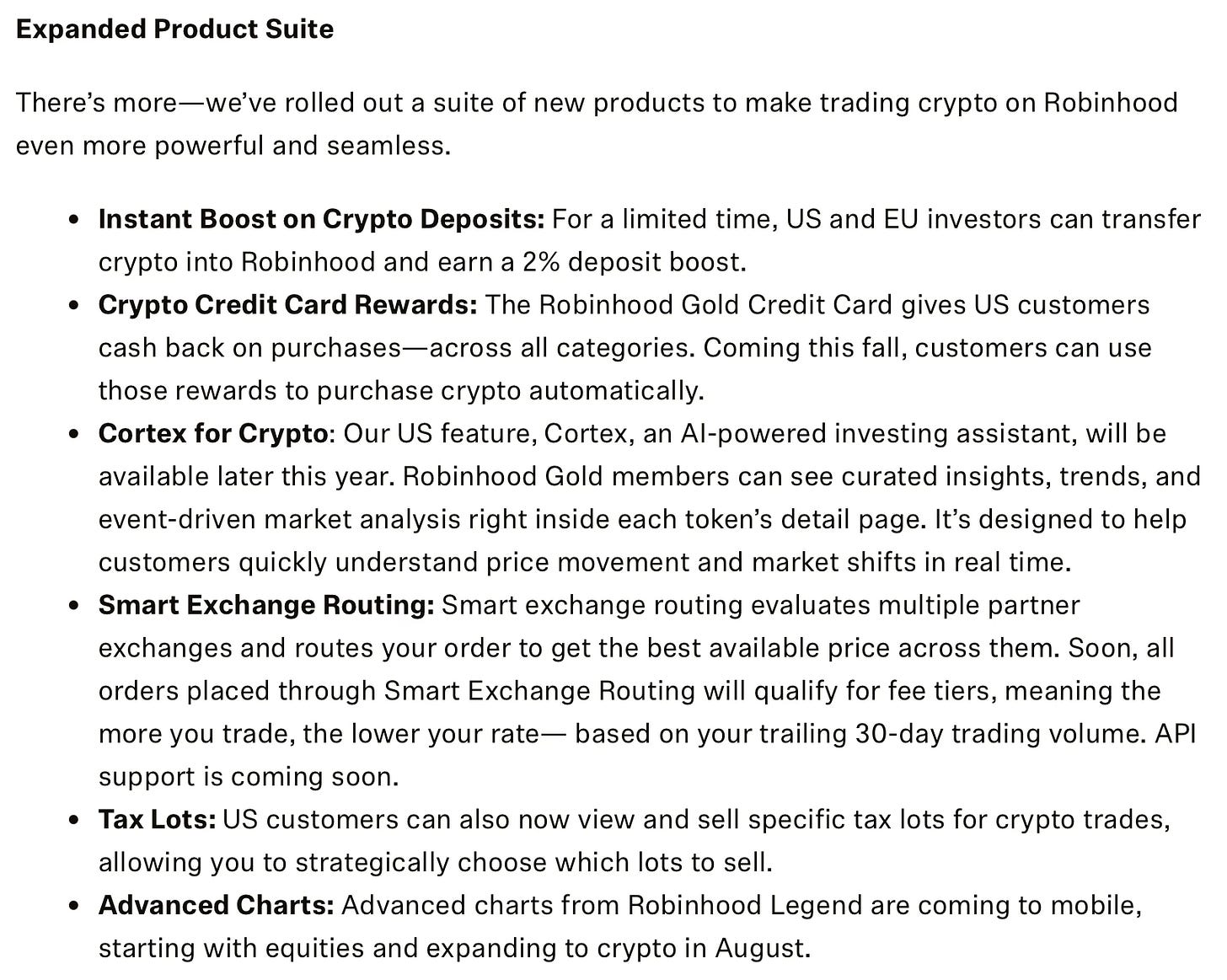Robinhood Marks the End of Crypto
Was Cannes a tipping point for crypto x tradfi?
Not so long ago, Ethereum was in a narrative crisis.
But Vlad Tenev & Robinhood just articulated the benefits of DeFi better than anyone ever has:
A 24/7 market;
The ability to expand globally without regulatory blockers (as exemplified by Robinhood’s EU strategy);
Access to unique instruments like Perpetuals;
Removing fees from the underlying settlement layer (via Robinhood Chain).
The Succession spin off event in Cannes marks the end of “crypto”: now it’s merely the future of France finance.
ROBINHOOD’S COMMITMENT
There are too many individual produts to articulate. so below is a quick summary in Robinhood’s own words and pictures (notice how the new meta is communicating crypto launches through iOS screenshots as opposed to whitepapers?).
Stock Tokens
Perpetuals
Staking
And more
This is nothing short of a strategic attempt to create the leading vertically integrated ecosystem for trading RWAs on crypto rails.
The Bankless interview was especially illuminating.
Robinhood had carefully considered what the 10x product was within both the US (staking) and EU (using crypto, private stocks and perps to bootstrap an invisibly crypto “Robinhood” app).
The two big questions that remain are: why Arbitrum and how will the new Robinhood stack impact ecosystem composability?
FINALLY, A WIN FOR ARBITRUM
In the same way that Base propelled the Superchain forward, the launch of Robinhood Chain will no doubt be a really impactful moment for Arbitrum.
So why didn't Robinhood go with the OP Stack?
This is not entirely obvious but here are my hypotheses:
Robinhood doesn't care about interop now. Arbitrum’s interop story is one of flexibility. The idea that any group of Arbitrum Orbit chains could form interop clusters seems to offer greater choice is appealing but in practice will likely mean that most Arbitrum chains will be late or won't capitalize on interop at all. Even Arbitrum One hasn't really formed an interop cluster whereas the Superchain ecosystem is already moving forward with fungible liquidity via SuperchainERC20, has an onramp chain + liquidity hub chain and will likely have a far superior user experience. It would be incorrect to say that they don't care about interop at all because they would have had other more attractive options like going with the OP Stack without a Superchain deal.
Robinhood are building a vertical ecosystem. In the Bankless interview Robinhood explained that they follow an Apple-like strategy of generally being a second mover and focusing on user experience over being “everything for everyone” like Base. With Robinhood Chain, they have a stated focus on RWAs but it’s also in the name. Instead of finding a broad and universal name suitable for a platform, they called it the “Robinhood Chain”.
Optimism had too much leverage. It’s possible that Optimism felt they had a sufficient corpus of chains and therefore simply didn't offer Robinhood a sufficiently attractive deal. In contrast, Coinbase received 118M OP tokens but effectively became the “Founding chain”.
Stylus. The benefits of Stylus were mentioned briefly as a way to leverage existing Rust code. I'm deeply skeptical of this kind of portability but I could foresee why Robinhood’s deal team may have found this attractive during vendor assessment.
10% < 15%. 15% (Optimism’s standard sequencer fee share) is a lot of value to give up and a delta of 5% vs. Arbitrum is actually a big number for the type of fee volume Robinhood could attract.
Keeping Base away. Unlike many other launches, Robinhood already has an active user group that is using very similar products to what would be offered on Robinhood Chain. Robinhood could move you from holding a stock vs. holding it onchain seamlessly whereas moving a Coinbase user to Base is harder. Robinhood may have feared that moving to the same interop cluster with Base could lead to Base syphoning off their user base. Instead, they can now be the dominant player in the Arbitrum ecosystem and write the rules in the same way that Coinbase did for the Superchain (bigger fish in a smaller pond).
INVISIBILITY VS. COMPOSABILITY AND THE VISION OF CRYPTO?
This vertical strategy presents certain risks to crypto and raises questions about our vision.
While one would expect us to do a victory lap, people in the industry have been disillusioned by this for different reasons.
People interested in mechanism design are getting bored because there are less and less original ideas in crypto as we move to a UX-driven adoption stage. We need a way to issue every asset onchain, a UX optimized order book, inventory for solvers (Uniswap v4), privacy and protected vaults (Aera) that allow off chain management and we know how those things look like.
The other pissed off group are people who thought they would win crypto just because they were early. They expected the complete dissolution of tradfi and hoped that their little startup will end up hiring JP Morgan VPs as they flee to become degens. Instead they now see they will be crushed by tradfi companies like Robinhood who have brand recognition, regulatory moats, people that actually work hard, a focus on user experience, trust with their customer and so on. It’s over.
Arbitrum claims that crypto’s vision was to always move in the background.
I'm not sure that’s entirely true.
For me, the goal wasn’t simply for crypto to become the financial rail with lower fees and smart contracts instead of people.
This has to happen while preserving the way crypto works now: composability, transparency and decentralization. While early signs are encouraging (Vlad committed to self-custody for private tokens), time will tell how committed Robinhood is to maintaining these aspects.
CLOSING NOTE ON RWAS
Betting on RWAs may seem like a focused strategy but one has to remember that traditional finance is all about “RWAs”, it’s only in this niche industry that we have created that other types of assets exist.
So in some ways this chart is showing growth in one slice of crypto, in other ways it is simply tracking the inevitable convergence of crypto and what we currently call “finance”.
















